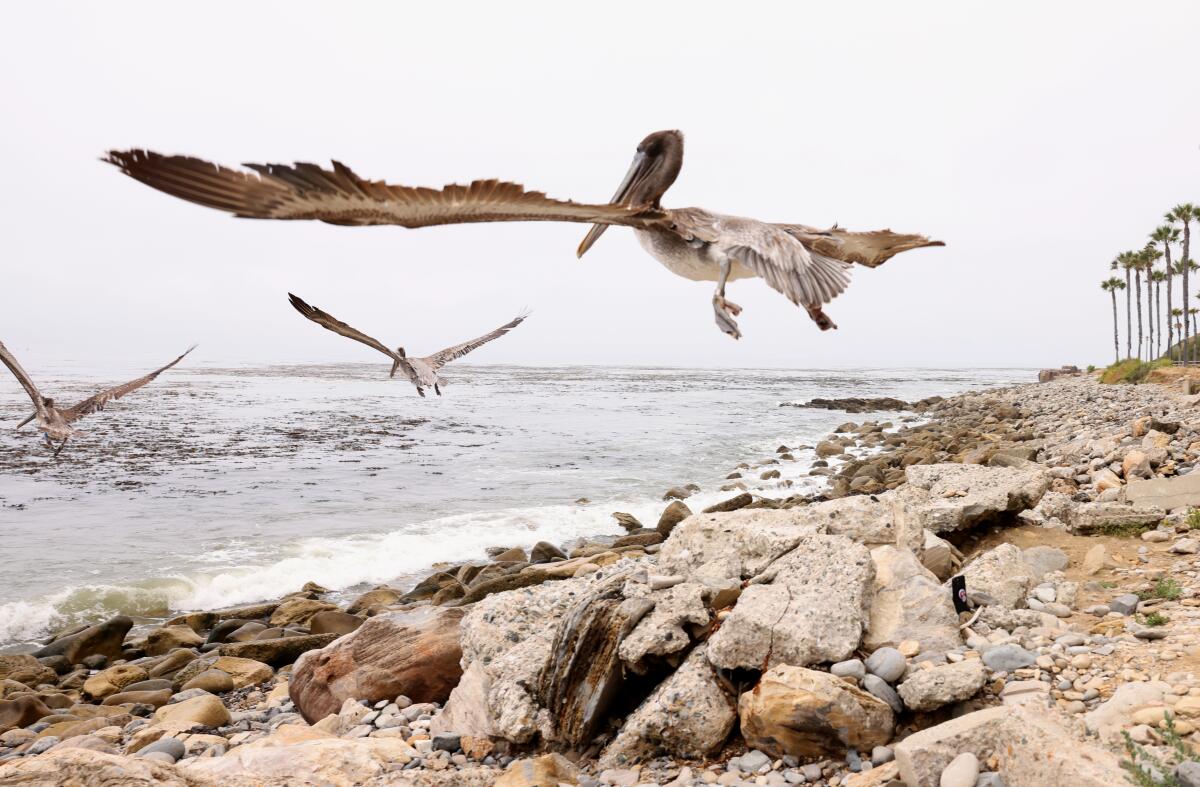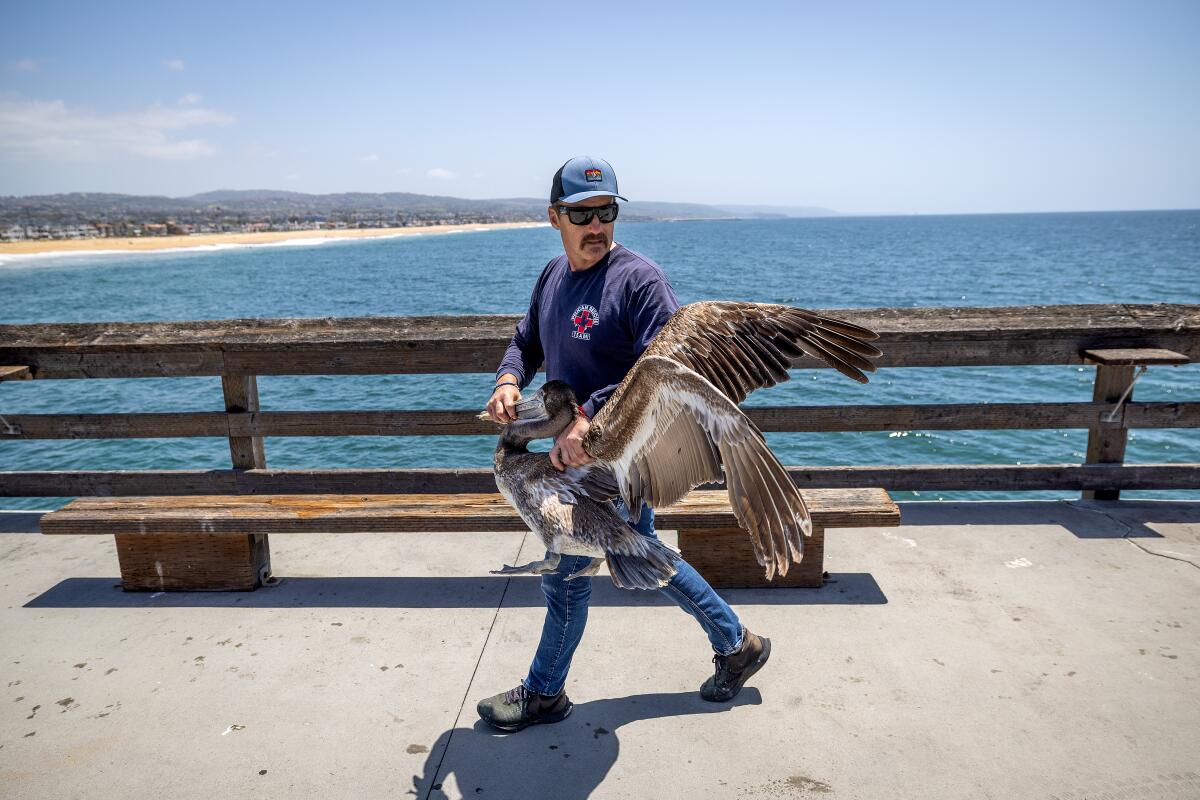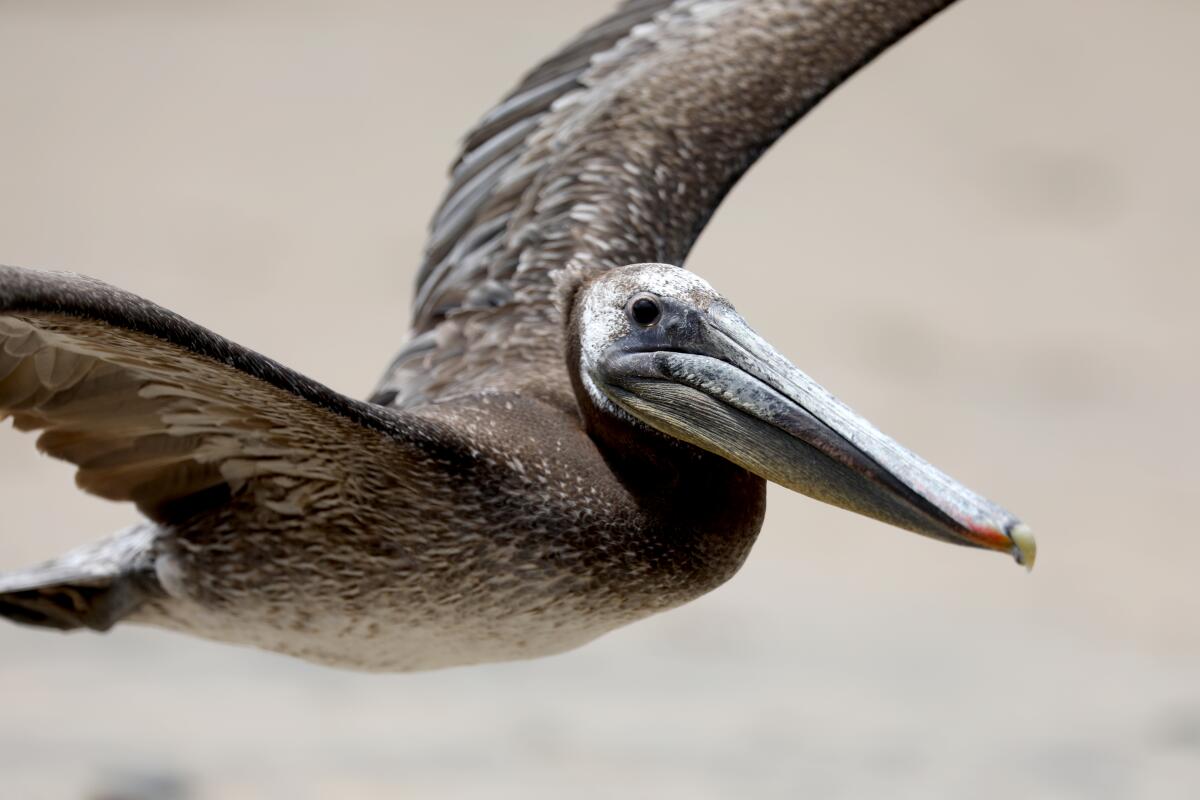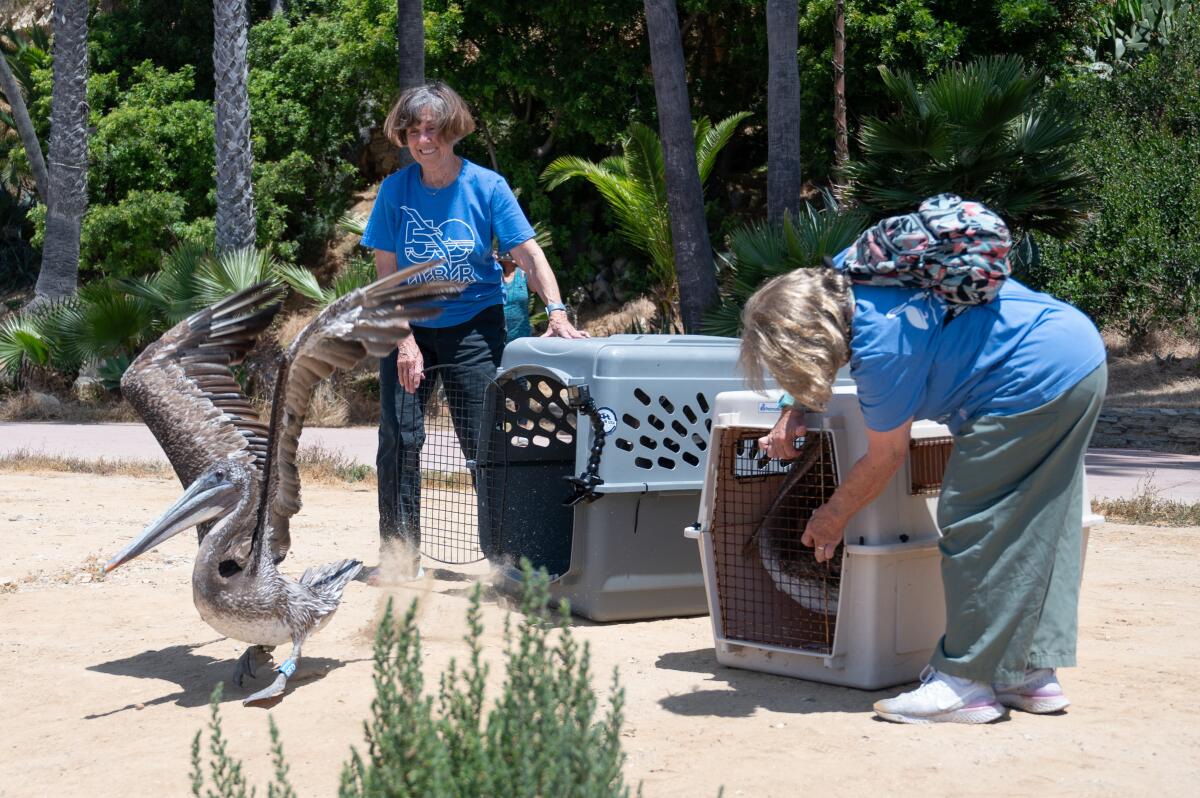Hundreds of starving brown pelicans have turned up. Scientists think they know why

- Share via
Good morning. It’s Friday, Aug. 23. Here’s what you need to know to start your day.
- Starving, injured brown pelicans are still being found on state beaches
- Harris and Trump find themselves in a 10-week sprint to the White House.
- 9 under-the-radar things to do on Catalina Island.
- And here’s today’s e-newspaper
You're reading the Essential California newsletter
Our reporters guide you through our biggest news, features and recommendations every morning
You may occasionally receive promotional content from the Los Angeles Times.
The brown pelicans’ latest plight
One common sight along the Golden State’s majestic coast is the California brown pelican. Whether in a tight formation gracefully gliding over the surf, resting on rocks or dotting dock posts in local harbors, the large seabirds are hard to miss.
But in recent months, many beachgoers have noticed something else about the once-endangered species: scores of them have been found emaciated and too weak to fly. Others have washed up dead in both Central and Southern California.
Wildlife officials say the pelicans’ primary food source is plentiful in coastal waters and avian flu was not detected in examined birds. So why are they starving to death?
Scientists are working to solve the mystery and have one leading theory, which could help wildlife agencies and rescue organizations better prepare for future pelican plights. Here’s what to know:

The leading theory
Dr. Rebecca Duerr, director of research and veterinary science at International Bird Rescue, estimated about 900 pelicans have been admitted to various care facilities in California since April, and about 450 of those birds came to her organization’s two rehab centers — one in the Bay Area and the other in Southern California.
Duerr is currently working on a report, along with state and federal wildlife agencies, examining the starvation crisis, expected to be completed by December. She said wildlife caregivers and government agencies that monitor wildlife, fisheries and ocean conditions also plan to meet this fall “to try to figure out what the heck is up with pelicans in California.”
But there is a leading theory: Brown pelicans dive for fish, so if they’re not catching any, then those would-be meals are either too deep for them to reach — or the pelicans can’t see them.
Scientists think weather patterns affecting ocean conditions might be to blame.
The state experienced strong storms this past winter and into early spring, which brought high winds and created a lot of choppy water along the coast, California Department of Fish and Wildlife spokesperson Tim Daly explained.
“Visibility was poor for the birds,” he said. “The waves were much higher and it was thought that the normal food for these guys was simply lower in the water than they were able to reach.”
This isn’t the first time California’s brown pelican population has experienced this crisis
A similar “stranding event” happened in spring 2022. During that time, roughly 800 starving pelicans were rescued in Southern California and placed into wildlife rehabilitation facilities, with about half successfully returned to the wild.
That’s when the theory about ocean conditions was first floated.
“There was a lot of winds in the Channel Islands vicinity off of Southern California,” Duerr noted. “That’s a huge area where pelicans [migrate from] breeding grounds and they’re trying to forage for fish. But having choppy surface waters can make it very difficult for them to see food.”
In 2022, the starvation appeared to be limited to Southern California. This year, according to Duerr, pelicans have been rescued in “odd hot spots,” with a concentration in Santa Cruz County.

Although the number of starving pelicans being rescued and treated has fallen from the peak in May, she said the current rate is still “higher than usual.”
More recently, there’s been an uptick of pelicans admitted with fractures and entangled in fishing gear, Duerr noted.
“When the animals in the wild are having trouble finding food, they seem to take more risks,” she said. “It’s not that they’re taking bait, necessarily, but that they get hooked on the outside of their body and then people cut them loose. … Then they get entangled and all sorts of bad things happen.”
Pelicans are resilient but face serious threats
International Bird Rescue has successfully released more than 240 California brown pelicans back into the wild so far this year. Duerr said one strength of the birds is their resilience.
“They’re the best patients in the world,” she said. “As long as we get them into care before they’re actually dead, they generally have a really good chance of recovery.”
Duerr pointed to research she worked on showing a majority of brown pelicans that were rescued, rehabbed, tagged and released between 2009 and 2019 were later seen alive in the wild.

The birds’ numbers are considered strong, despite the die-off, both Duerr and Daly noted. California brown pelicans were on the state and federal endangered species list for decades, but were removed in 2009 as the population thrived along the West Coast.
The birds were pushed to the brink of extinction by the pesticide DDT, which made its way into the ocean and contaminated their food supply.
But as Duerr told me, there’s renewed concern about DDT and its effects on the seabirds.
Researchers are testing pelicans that didn’t survive in rehab. Samples from the first seven birds revealed they were “highly contaminated” with DDT and other compounds, she said. Tests on more than 30 more pelicans are in the works.
Duerr credits previous reporting from The Times on the legacy of DDT ocean dumping for helping to secure funding for the testing and other research to better understand the environmental impacts.
“Are there some clinical effects of this level of contamination on these animals? We don’t know, [but] we’re working on it,” Duerr said.
“We may end up in a position where we humans [need] to manage everything just because of the changes we brought in the world.”
Officials are set to convene and could develop a possible pelican alert
Working off the theory that rough ocean conditions are to blame, Daly told me the various agencies plan to “be a little better prepared” to respond to hungry pelicans moving forward.
The goal would be that when similar weather patterns are developing along the coast, officials can spring into action so that rehab centers are stocked with food ahead of time “as opposed to scrambling at the time to find the food and the funding,” he said.
Wildlife officials could also issue public alerts so people are aware that there may be sick or injured pelicans in their area, especially where humans are fishing.
“We’d like to do a better job of communicating with the public and the fishing industry … that it’s entirely possible that this type of event could happen again,” he said.
What to do if you see a pelican in distress

Wildlife officials advise people not to approach or touch sick or injured birds and instead contact local wildlife rescue groups.
International Bird Rescue operates a Bird HelpLine. To report a pelican in need of help in Southern California, call (310) 402-0642. For Northern California, the number is (707) 456-4528.
The group also has a web tool that allows people to report sightings of tagged brown pelicans by inputting their band number (and photos are encouraged). Its SoCal center also runs a live PeliCam where you can see how the birds are doing.
You can also contact your regional Department of Fish and Wildlife office or check this list of other rehab centers compiled by the department.
Today’s top stories

Vice President Kamala Harris accepted the Democratic nomination for president
- Harris staked out her vision for unifying the country while confronting her opponent.
- Harris and Trump now find themselves in a 10-week sprint to the White House.
- South Asian donors gave almost $2.4 million to Harris in the first days of her campaign.
- Tim Walz’s son Gus has a nonverbal learning disorder, which has been described as the opposite of dyslexia.
- Beyoncé did not perform during the final night of the DNC. But pop fandom still stole the show.
A homeless encampment at Dockweiler State Beach near LAX was cleared by city workers
- The encampment frustrated nearby residents, who said garbage, campfires, hypodermic needles and feces littered the beach.
- The cleanup came more than a month after Gov. Gavin Newsom threatened to take away state funding from counties that don’t tackle the homelessness crisis.
- City staff are also identifying encampments in Long Beach that pose a public threat or block access to public services.
- The issue of people living on the streets persists as home prices rise and not enough new homes are built.
The ‘Ketamine Queen’ charged in actor Matthew Perry’s death
- Federal prosecutors allege Jasveen Sangha operated a lucrative narcotics business and supplied the ketamine Perry injected on the day of his death
- Sangha is one of five people charged in the actor’s death.
In a stunning move, Tom Girardi took the witness stand
- The disgraced former attorney denied stealing client funds, insisted he never took a salary from the firm and shifted blame onto his law firm’s CFO.
- When asked about purchasing jewelry for his now-estranged wife, “Real Housewives of Beverly Hills” star Erika Girardi, he insisted he did not use client funds.
L.A. influencers post everything online. It can make them “easy marks”
- Social media influencers have been targeted in burglaries and robberies recently after posting their locations and high-end goods online.
- Influencers — a thriving part of the L.A. culture economy — make up an industry predicted to grow to half a trillion dollars in the next four years.
More big stories
- Mpox is again a global health emergency. How concerned should Californians be?
- The final orange grove in the San Fernando Valley is likely to give way to luxury homes.
- With the strike behind them, Los Angeles hotels look to move on.
- VIPs could drink alcohol until 4 a.m. at the new Clippers arena if this bill becomes law.
- Beloved chicken chain Koo Koo Roo readies for a comeback.
- Rescuers happened upon a celebrity while searching for a 78-year-old hiker in the California wilderness.
Get unlimited access to the Los Angeles Times. Subscribe here.
Commentary and opinions
- What kind of prosecutor was Kamala Harris? The answer could be pivotal to her campaign, Harry Litman writes.
- California should lead on AI regulation, the Editorial Board explains.
- We’re living under a flawed Constitution. Let’s start fresh and rewrite it, Erwin Chemerinsky suggests.
- Tipping culture is out of control. Trump and Harris would make it worse, Virginia Postrel writes.
Today’s great reads
Drug cartels’ turf war in Mexico’s Chiapas state sends villagers fleeing to Guatemala. An escalating turf war engulfing much of Mexico’s heavily Indigenous Chiapas state has displaced thousands as gangs battle for drug- and gun-trafficking routes.
Other great reads
- The family behind Koda Farms, the creator of beloved rice strains such as Kokuho Rose and Sho-Chiku-Bai, will end rice production after nearly 100 years.
- A fight is underway to save the last pieces of the historic Japanese fishing village on Terminal Island.
How can we make this newsletter more useful? Send comments to essentialcalifornia@latimes.com.
For your downtime

Going out
- 📷 Here are nine under-the-radar things to do on Catalina Island, a charming getaway with European vibes.
- 🍸 One of the best restaurants in L.A. now operates a tandem bar serving effervescent micheladas rimmed with house-made chamoy.
- 🏖️ Before summer ends, check out the 50 best beaches in Southern California.
Staying in
- 📖 The new memoir “That Librarian” is a troubling portrait of America’s culture war over censorship and book banning.
- 📺 Robert Downey Jr. revealed how Kevin Feige persuaded him to return as Doctor Doom.
- 🐐 Can the Antichrist save “Evil”? The co-creators and star explain the show’s finale and future.
- 🧑🍳 Here’s a recipe for a big and boozy panna cotta.
- ✏️ Get our free daily crossword puzzle, sudoku, word search and arcade games.
And finally ... a great photo
Show us your favorite place in California! We’re running low on submissions. Send us photos that scream California and we may feature them in an edition of Essential California.
Today’s great photo is from staff writer Jaclyn Cosgrove, who visited the Cave of Munits for The Times’ guide to the 70 best hikes in L.A.
Have a great day, from the Essential California team
Ryan Fonseca, reporter
Defne Karabatur, fellow
Andrew Campa, Sunday reporter
Hunter Clauss, multiplatform editor
Christian Orozco, assistant editor
Stephanie Chavez, deputy metro editor
Karim Doumar, head of newsletters
Check our top stories, topics and the latest articles on latimes.com.
Sign up for Essential California
The most important California stories and recommendations in your inbox every morning.
You may occasionally receive promotional content from the Los Angeles Times.









